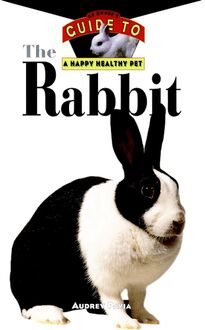-
 Univers
Univers
-
 Ebooks
Ebooks
-
 Livres audio
Livres audio
-
 Presse
Presse
-
 Podcasts
Podcasts
-
 BD
BD
-
 Documents
Documents
-
- Cours
- Révisions
- Ressources pédagogiques
- Sciences de l’éducation
- Manuels scolaires
- Langues
- Travaux de classe
- Annales de BEP
- Etudes supérieures
- Maternelle et primaire
- Fiches de lecture
- Orientation scolaire
- Méthodologie
- Corrigés de devoir
- Annales d’examens et concours
- Annales du bac
- Annales du brevet
- Rapports de stage
La lecture à portée de main
Vous pourrez modifier la taille du texte de cet ouvrage
Découvre YouScribe en t'inscrivant gratuitement
Je m'inscrisDécouvre YouScribe en t'inscrivant gratuitement
Je m'inscrisEn savoir plus
Vous pourrez modifier la taille du texte de cet ouvrage
En savoir plus

Description
At last, a book about your pet that emphasizes total care, training and companionship! You'll not only learn about the specie-specific traits of your special pet, you'll also learn what the world's like from your pet's perspective; how to feed, groom and keep your pet healthy; and how to enjoy your pet through training and activities you can do together.
The Siberian Husky is written by a breed expert and includes a special chapter on training by Dr. Ian Dunbar, internationally renowned animal behaviorist, and chapters on getting active with your dog by long-time Dog Fancy magazine columnist Bardi McLennan.
Best of all, the book is filled with info-packed sidebars and fun facts to make caring for your pet easy and enjoyable.
PART ONE: Welcome to the World of the Siberian Husky.
1. What Is a Siberian Husky?
2. The Siberian Husky's Ancestry.
3. The World According to the Siberian Husky.
PART TWO: Living with a Siberian Husky.
4. Bringing Your Siberian Husky Home Feeding Your Siberian Husky.
6. Grooming Your Siberian Husky.
7. Keeping Your Siberian Husky Healthy.
PART THREE: Enjoying Your Dog.
8. Basic Training (Ian Dunbar, Ph.D., MRCVS).
9. Getting Active with Your Dog (Bardi McLennan).
10. Your Dog and Your Family (Bardi McLennan).
11. Your Dog and Your Community (Bardi McLennan).
PART FOUR: Beyond the Basics.
12. Recommended Reading.
13. Resources.
Sujets
Informations
| Publié par | Turner Publishing Company |
| Date de parution | 05 mai 2008 |
| Nombre de lectures | 0 |
| EAN13 | 9780470370902 |
| Langue | English |
| Poids de l'ouvrage | 2 Mo |
Informations légales : prix de location à la page 0,0900€. Cette information est donnée uniquement à titre indicatif conformément à la législation en vigueur.
Extrait
The
Siberian Husky
Howell Book House
A Simon Schuster Macmillan Company
1633 Broadway
New York, NY 10019
Copyright 1996 by Howell Book House
All rights reserved. No part of this book may be reproduced or transmitted in any form or by any means, electronic or mechanical, including photocopying, recording, or by any information storage and retrieval system, without permission in writing from the Publisher.
MACMILLAN is a registered trademark of Macmillan, Inc.
Library of Congress Cataloging-in-Publication Data
Sikora-Siino, Betsy.
The Siberian Husky: an owner s guide to a happy, healthy pet/Betsy Sikora-Siino.
p. cm.
Includes bibliographical references.
ISBN: 0-87605-395-9
1. Siberian huskies. I. Title.
SF429.S65S56 1996
636.7 3-dc20 95-47934
CIP
Manufactured in the United States of America
10 9 8 7 6 5 4 3 2 1
Series Director: Dominique DeVito
Series Assistant Director: Ariel Cannon
Book Design: Michele Laseau
Cover Design: Iris Jeromnimon
Illustration: Jeff Yesh
Photography:
Cover: Joan Balzarini, puppy by Judith Strom
Courtesy of the American Kennel Club: 15, 17, 20, 21
Courtesy of Ken-L Ration: 93
Joan Balzarini: 8, 14, 46, 66, 96
Mary Bloom: 96, 136, 145
Buckinghamhill American Cocker Spaniels: 148
Sian Cox: 134
Dr. Ian Dunbar: 98, 101, 103, 111, 116-117, 122, 123, 127
Dan Lyons: 96
Cathy Merrithew: 129
Liz Palika: 133
Susan Rezy: 11, 12, 48, 57, 62, 81, 96-97, 136, 145
Karrin Winter/Dale Churchill: 5, 6, 24, 31, 53, 54, 58, 59, 61
Paulette Braun/Pets by Paulette: 7, 38, 41, 55, 96
Scott McKiernan/Zuma: 22, 44, 70, 134
Judith Strom: 26, 27, 28, 29, 96, 107, 110, 128, 130, 135, 137, 139, 140, 144, 149, 150
Ted Schiffman/Animal Images: 40, 43, 76
Production Team: Trudy Brown, Jama Carter, Kathleen Caulfield, Trudy Coler,
Amy DeAngelis, Pete Fornatale, Matt Hannafin, Kathy Iwasaki, Vic Peterson,
Terri Sheehan, Marvin Van Tiem, and Kathleen Varanese
Contents
part one
Welcome to the World of the Siberian Husky
1 What Is a Siberian Husky?
2 The Siberian Husky s Ancestry
3 The World According to the Siberian Husky
part two
Living with a Siberian Husky
4 Bringing Your Siberian Husky Home
5 Feeding Your Siberian Husky
6 Grooming Your Siberian Husky
7 Keeping Your Siberian Husky Healthy
part three
Enjoying Your Dog
8 Basic Training
by Ian Dunbar, Ph.D., MRCVS
9 Getting Active with Your Dog
by Bardi McLennan
10 Your Dog and Your Family
by Bardi McLennan
11 Your Dog and Your Community
by Bardi McLennan
part four
Beyond the Basics
12 Recommended Reading
13 Resources
part one
chapter 1
What
Is a
Siberian
Husky?
The Siberian Husky is a dog everyone knows. Although it is not the most popular pet, it is one of the most well-known American dog breeds, even among those who really don t know dogs. The reason is simple: When someone offhandedly throws out the generic term husky or hears of a sled dog race in Alaska, invariably the image of the Siberian Husky, a blue-eyed dog that looks like a wolf, takes shape within the mind s eye.
Despite obvious similarities in appearance and a shared affinity for howling, the Siberian Husky is no closer to the wolf than is any other domestic dog. He does share, however, an intimate knowledge of the wilderness with his wild cousin, for both have evolved in some of the harshest, most remote regions on earth.
A Strong Survivor
From such an environment has sprung a dog with speed, endurance and a friendly attitude that somehow belies the animal s great athletic ability. That dog is, of course, the Siberian Husky-the dog harnessed to a primitive sled, mushed by a fur-clad Eskimo across the frozen tundra, immortalized by Jack London in The Call of the Wild -the dog that carries our imaginations to the top of the world where only the fittest survive.
The Husky s eyes entrance all who look at them; they can be brown, blue or even one of each color.
Despite his great beauty and infectious smile, the Siberian Husky is one of those illustrious fittest. Through human-assisted natural selection, he has proven he can happily survive almost anywhere. Yet the Siberian is shrouded in myth and legend, leaving modern humans to sort out what is real and what is fiction-something the Siberian owner must do if he or she is to become the partner this dog demands.
The Husky s Heritage
Although much of the Siberian s legend is just that, the truths of the breed at times seem mythological. The credit for these myths goes to the many people throughout history who have guided the breed s fate with wisdom and respect. Entrusted with a dog bred for an estimated three thousand years by the Chukchis of Siberia, today s American breeders, armed with the American Kennel Club (AKC) standard that dictates the ins and outs of Siberian breeding, continue to do justice to what those native breeders intended for their treasure. Were those ancient Chukchis transported forward in time, they would probably have little trouble recognizing their dogs in a gathering of twentieth-century canines.
Huskies can come in all colors, from black to pure white, like this one.
A Big Dog in a Not-So-Big Package
What might surprise the neophyte viewing a Siberian Husky for the first time is the dog s relatively small size. How could this diminutive, almost delicate creature be the grand dog of the north? the inspiration of countless adventure fantasies? Jack London s muse?
The Siberian Husky was designed for ultimate efficiency, that s how. What follows is a discussion of the physical characteristics of the Siberian Husky, based on the breed s standard. For a copy of the official standard, write to the American Kennel Club, 51 Madison Avenue, New York, NY 10010.
Height According to the official standard of the breed as accepted by the American Kennel Club (AKC) and evident in most of the Siberians seen today, this high-powered athlete should stand just under two feet at the withers. Specifically, females should stand twenty to twenty-two inches, males twenty-one to twenty-three-and-one-half inches. Females should weigh thirty-five to fifty pounds, males forty-five to sixty pounds.
The Siberian Husky is quite a bit smaller than the Alaskan Malamute, another wolfy-looking Arctic breed that, despite the dramatic size differences, is often mistaken for his smaller cousin and vice versa. Nevertheless, that smaller cousin continues to amaze spectators and enthusiasts alike as one of the smallest, yet most capable dogs in the AKC s Working Group.
Build The Siberian Husky is described in the standard as a medium-sized working dog, quick and light on its feet and free and graceful in action. It is precisely this image, one the dog readily embodies, that has drawn so many people from so many cultures to this breed.
The Siberian s profile resembles that of the wolf.
Elegant and athletic, compact and well balanced, the well-bred Siberian Husky cuts a sturdy figure with moderate bone and hard muscle, which facilitate the extraordinary strength and endurance for which the breed is known.
Engineered to move almost effortlessly across the snow and ice, the Siberian boasts straight, parallel front legs with elbows held close to the body. The hindquarters are equally straight and parallel, the thighs rich with powerful muscle to propel the dog forward with balance and precision.
Tail Assisting in that mission is the tail, well-furred (though not too well-furred or too tightly curled) and carried over the back when the dog is alert and attentive. When relaxed, the Siberian s tail is dropped. When excited, no doubt when greeting either a known family member or a new acquaintance, the Siberian s tail wags wildly like a flag flying high above his back.
Feet Whereas the tail adds balance and is a means of communicating moods, the structure of the Siberian s feet enables the dog to move in a way that makes one think the animal must surely be running on air. To keep the Siberian stepping lightly, those feet should be oval in shape and of medium size with thick, protective pads underneath and a dense growth of hair between the pads and toes. Such accoutrements provide the dog with traction and protection from frigid climates and rugged terrain. The Siberian can thus run tirelessly in the coldest of temperatures. To watch him move with such effortless grace is to witness the ideal marriage of agility and elegance.
WHAT IS A BREED STANDARD?
A breed standard-a detailed description of an individual breed-is meant to portray the ideal specimen of that breed. This includes ideal structure, temperament, gait, type-all aspects of the dog. Because the standard describes an ideal specimen, it isn t based on any particular dog. It is a concept against which judges compare actual dogs and breeders strive to produce dogs. At a dog show, the dog that wins is the one that comes closest, in the judge s opinion, to the standard for its breed. Breed standards are written by the breed parent clubs, the national organizations formed to oversee the well-being of the breed. They are voted on and approved by the members of the parent clubs.
Breathtaking Beauty
Eyes For most people, it s the Siberian s glacier-blue eyes that first capture their attention. But while all Siberians see through almond-shaped, almost humanly expressive eyes, not all Siberians see the world through eyes of blue.
The standard allows eyes that are brown, blue or even one of each. Particolored eyes are also acceptable. Look closely into those eyes, which have been known to unnerve if not outright frighten the uninitiated, and you may just note a hint of wanderlust smoldering within.
Head Even with those mysterious eyes, the Siberian s expression is one of energy and exuberance and even, as the standard suggests, projects an element of mischief.
The Siberian s profile resembles that of the wolf: his muzzle medium in width, tapered to the nose; the triangular-shaped, well-
-
 Univers
Univers
-
 Ebooks
Ebooks
-
 Livres audio
Livres audio
-
 Presse
Presse
-
 Podcasts
Podcasts
-
 BD
BD
-
 Documents
Documents
-
Jeunesse
-
Littérature
-
Ressources professionnelles
-
Santé et bien-être
-
Savoirs
-
Education
-
Loisirs et hobbies
-
Art, musique et cinéma
-
Actualité et débat de société
-
Jeunesse
-
Littérature
-
Ressources professionnelles
-
Santé et bien-être
-
Savoirs
-
Education
-
Loisirs et hobbies
-
Art, musique et cinéma
-
Actualité et débat de société
-
Actualités
-
Lifestyle
-
Presse jeunesse
-
Presse professionnelle
-
Pratique
-
Presse sportive
-
Presse internationale
-
Culture & Médias
-
Action et Aventures
-
Science-fiction et Fantasy
-
Société
-
Jeunesse
-
Littérature
-
Ressources professionnelles
-
Santé et bien-être
-
Savoirs
-
Education
-
Loisirs et hobbies
-
Art, musique et cinéma
-
Actualité et débat de société
- Cours
- Révisions
- Ressources pédagogiques
- Sciences de l’éducation
- Manuels scolaires
- Langues
- Travaux de classe
- Annales de BEP
- Etudes supérieures
- Maternelle et primaire
- Fiches de lecture
- Orientation scolaire
- Méthodologie
- Corrigés de devoir
- Annales d’examens et concours
- Annales du bac
- Annales du brevet
- Rapports de stage




















